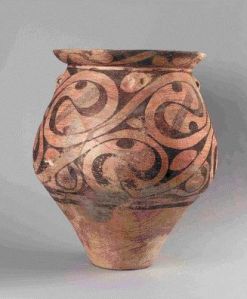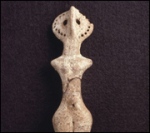 I must say, I’m not used to thinking of the ancient Egyptians or Sumerians as latecomers in the “civilization” department.
I must say, I’m not used to thinking of the ancient Egyptians or Sumerians as latecomers in the “civilization” department.
But after visiting the Royal Ontario Museum last weekend and seeing the exhibit, “Mysteries of Ancient Ukraine: The Remarkable Trypilian Culture,” I’m forced to reconsider everything I thought I knew about the beginnings of history.
To say this was a sophisticated society is an understatement. Where I expected perhaps some bits of primitive pottery and rough arrowheads (the culture went back to 5000 BCE, after all), there were large, elaborately painted pots, small models of houses, detailed figurines, bowls and cups, and other sculptures. The Trypilians were already living together in surprisingly large numbers, with a surprisingly complex society of art and culture, when the Egyptians and Sumerians were only starting to stir.
 This culture was the first to build what can only be called cities, the biggest settlements with populations as large as 15,000 people. They were both hunters and farmers, living in large dwellings, some of them two storeys high. According to the posted information, there’s nothing yet that reveals their political structure, and strangely, no one has ever found cemeteries or discovered their funerary arrangements. But every three or four generations, they would burn down their settlements and move elsewhere.
This culture was the first to build what can only be called cities, the biggest settlements with populations as large as 15,000 people. They were both hunters and farmers, living in large dwellings, some of them two storeys high. According to the posted information, there’s nothing yet that reveals their political structure, and strangely, no one has ever found cemeteries or discovered their funerary arrangements. But every three or four generations, they would burn down their settlements and move elsewhere.
The Trypilian culture is still not well known in the wider world, even though it was discovered in 1896, near the village of Trypillia, by archaeologist Vikenty Khvoika. Perhaps political matters in that area overshadowed archaeology for a few decades, meaning that the world didn’t get a chance to become familiar with this society.
 Whatever the case, we’ve had a good look at it now, thanks largely to the request of Ukrainian President Victor Yushchenko. During his election to office in 2004, he met with the chair of the ROM’s board of directors, James Temerty, then in the country as a Canadian observer. Yushchenko, who has himself collected some pieces of Trypilian pottery, asked Temerty if the ROM would put this exhibition together, so the world would finally become aware of Ukraine’s deep cultural roots.
Whatever the case, we’ve had a good look at it now, thanks largely to the request of Ukrainian President Victor Yushchenko. During his election to office in 2004, he met with the chair of the ROM’s board of directors, James Temerty, then in the country as a Canadian observer. Yushchenko, who has himself collected some pieces of Trypilian pottery, asked Temerty if the ROM would put this exhibition together, so the world would finally become aware of Ukraine’s deep cultural roots.
And so it transpired, four years later, with the ROM having the distinction of organizing the entire exhibit, and being the first museum in the world to bring this culture out of Ukraine on such a scale.
 The atmosphere in the exhibit is warm and intimate. Curving corridors walled with lattices of dark wood imitate the complex sworls that decorate the huge pots, each short hallway curving into another section of the exhibit. The largest pots, several loaned by Yushchenko himself, stand on pedestals so observers can circle them and take in the detail of their painted designs. Smaller objects are placed in well lit cases, the figurines gazing distantly back through the glass, and the odd “binoculars” (like two tankards connected together, but with open bottoms) providing an unsolved mystery, since no one knows what they were used for.
The atmosphere in the exhibit is warm and intimate. Curving corridors walled with lattices of dark wood imitate the complex sworls that decorate the huge pots, each short hallway curving into another section of the exhibit. The largest pots, several loaned by Yushchenko himself, stand on pedestals so observers can circle them and take in the detail of their painted designs. Smaller objects are placed in well lit cases, the figurines gazing distantly back through the glass, and the odd “binoculars” (like two tankards connected together, but with open bottoms) providing an unsolved mystery, since no one knows what they were used for.
My friend and I are always sceptical when some ancient artifact is automatically deemed to be of a religious nature. And I mused, wandering from case to case, whether having a look at Ukrainian cultures that succeeded this one might give a clue to the real beliefs of the Trypilians. Some ideas do survive through folk tales, songs, and so on.
 This fact struck us as we looked at the miniature houses, thinking of them as doll houses rather than ritual objects. We were mystified about why these miniatures were all on stilts or legs, when real Trypilian dwellings stood firmly on the ground.
This fact struck us as we looked at the miniature houses, thinking of them as doll houses rather than ritual objects. We were mystified about why these miniatures were all on stilts or legs, when real Trypilian dwellings stood firmly on the ground.
Then my friend remembered the Slavic story of the Hut on Fowl’s Legs. Could we have been observing the truly ancient root of that old folk tale? It’s an intriguing idea.
The exhibit’s last day is this coming Sunday (March 22, 2009). Rumour has it that the Metropolitan Museum of Art in New York City now wishes to show this Trypilian collection, and has engaged in negotiations. If true, Victor Yushchenko’s wish is coming true. The world is finally discovering that its earliest great civilization may have originated in Ukraine, and not farther south. This could force historians the world over to rethink their assumptions about humanity’s early history.
Egypt and Sumeria, move over!
******************************
(For an account of the exhibit’s opening, and more information about it, see this article originally published in the National Post.)